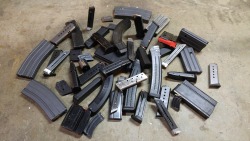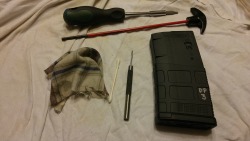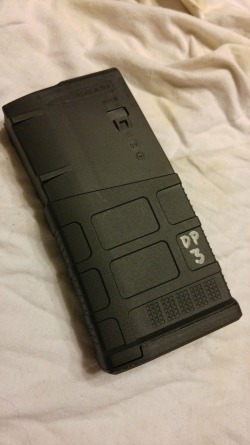The AR-15. AK-47. M1A. Glock 17. SIG Sauer P226. Colt 1911. S&W M&P. CZ-75. Beretta 92. Ruger 10/22.  H&K MP5. Walther P22. All of these firearms each have an army of diehard pundits in the firearms world. You probably have at least one of them incorporated in your SHTF plans. It’s possible your very life and chances of survival will depend on one of these some day. However, they all have a common weakness, a vulnerability that can reduce these fine pieces of weaponry to single-shot, barely useful clubs: the detachable magazine.
H&K MP5. Walther P22. All of these firearms each have an army of diehard pundits in the firearms world. You probably have at least one of them incorporated in your SHTF plans. It’s possible your very life and chances of survival will depend on one of these some day. However, they all have a common weakness, a vulnerability that can reduce these fine pieces of weaponry to single-shot, barely useful clubs: the detachable magazine.
By Drew, a contributing author
Modern Flaws
Even though modern magazine designs, construction methods, and materials are top-notch, they can still fail. Neglect, slightly bent or damaged feed lips, worn magazine springs, sloppy followers, and/or just plain, simple dirt will positively destroy the functioning of an otherwise flawlessly-working gun…and these problems can be virtually undetectable if you don’t know what to look for. Therefore, magazine maintenance should be of the utmost priority – just as important as the cleanliness of the firearm – for anyone who plans on relying on an autoloading firearm when the chips are down.
However, firearms with detachable magazines aren’t the only problem guns – your grandfather’s trusty old Winchester 1894 .30-30 lever action could have magazine problems. So could the Remington 870 you leave with a loaded magazine in the closet in case of emergency. If your gun is a magazine-fed repeater – detachable or fixed – that feeding system needs to be taken care of. It’s your gun’s lifeblood…and by extension, that means it could be your lifeblood as well. Magazine maintenance is probably the most purposely neglected (“I’ll get it later…”) and/or forgotten aspect of gun cleaning, but it could be considered one of the most important. (We’ll address fixed magazine guns in a future article.)
The Detachable Magazine
The detachable magazine comes in a myriad shapes, sizes, lengths, capacities, colors, and methods of  construction. However, the vast majority of “box” magazine designs have similar components: the magazine body, the magazine follower, the locking plate, and the baseplate. Rotary type magazines (such as the Ruger 10/22’s nifty little cartridge feeder) are a bit of a different animal, but the principles are the same – they just keep the cartridges in a circular holding pattern inside the magazine, instead of in a straight vertical stack. Generally, magazines are very simple in design, and really, with just a bit of semi-regular maintenance and cleaning, they will be virtually trouble-free. Most of the parts don’t require replacing or fixing; the only component that may need to be replaced is the magazine spring if the magazine hasn’t seen any damage.
construction. However, the vast majority of “box” magazine designs have similar components: the magazine body, the magazine follower, the locking plate, and the baseplate. Rotary type magazines (such as the Ruger 10/22’s nifty little cartridge feeder) are a bit of a different animal, but the principles are the same – they just keep the cartridges in a circular holding pattern inside the magazine, instead of in a straight vertical stack. Generally, magazines are very simple in design, and really, with just a bit of semi-regular maintenance and cleaning, they will be virtually trouble-free. Most of the parts don’t require replacing or fixing; the only component that may need to be replaced is the magazine spring if the magazine hasn’t seen any damage.
Concerning the spring: you’ve probably heard/read the age-old debate: does leaving magazines loaded for an extended period of time weaken the springs? The general consensus from magazine manufacturers seems to be that leaving them loaded, even over years, does not induce spring failure. Far and away, the most common cause of spring failure is the fatigue caused by constant loading and unloading. Nobody can put a finger on an exact number of rounds that it takes to make a magazine spring fail, so a good way to keep an eye on things is to get a paint marker or silver Sharpie and number your magazines.
Also Read: SHTF Armorer AR15 Bolt Carrier Group
Try to keep a general round count of the number of rounds that have been put through them if possible. When one of your magazines starts to fail or cause firearm malfunctions, (this usually takes thousands of rounds) check the magazine’s round count and use that as a guideline for the other magazines of the same make and capacity. Replace the magazine spring accordingly, at appropriate intervals. Some of us may never run enough rounds through a gun to have to worry about this issue…but it’s always good to have an extra magazine spring or, even better, extra magazine(s) kicking around, just in case.
Another issue: If you drop your magazine on the feed lips and bend them, you have a problem. Most magazines I’ve run have never had a spring failure, but have suffered damage from being dropped onto the feed lips. If you have a polymer magazine like a Magpul PMAG, chances are pretty good you’re still in business. However, steel magazine bodies that have damaged feed lips are probably not worth keeping.
Related: Survival Armorer Basic Kit
You can try to bend them back to factory spec, but the metal has been fatigued, and now has an excellent starting fracture point for future breaking or malforming. If you’re not in a dire SHTF situation, pull the magazine apart, keep the baseplate, spring, and follower, and junk the magazine body. It’s not worth the headache and possible failure to try making the old magazine work. A new magazine is a few bucks – a failure in a survival situation could mean death. Don’t hedge your bets if you don’t have to.
The Body
The same goes for the magazine body: if you accidentally step on a steel/aluminum magazine, check the sides of  the magazine for dents or damage, and try to run some rounds through it. A pinched magazine body might not have clearance to allow rounds to be loaded, or to be fed. This has happened to me before with metal bodied GI-issued AR magazines…all the more reason to look into polymer magazines like the excellent Magpul PMAG.
the magazine for dents or damage, and try to run some rounds through it. A pinched magazine body might not have clearance to allow rounds to be loaded, or to be fed. This has happened to me before with metal bodied GI-issued AR magazines…all the more reason to look into polymer magazines like the excellent Magpul PMAG.
An excellent basic test, especially for AR magazines, is to load the magazine up to capacity, and then turn it upside down and briskly smack the baseplate at the bottom of the magazine. If rounds fall out, chances are excellent that your feed lips are out of spec or your magazine spring does not have sufficient strength to keep enough tension on the rounds to feed the gun reliably.
You will find some older or smaller gun designs have steel bodied magazines with welded or silver-soldered fixed baseplates. For these, there’s not much you can do but baby the magazines you have and keep spares. They’re probably from an older design, so for the purposes of a SHTF gun, I might consider going a different route with a modern firearm platform design that utilizes magazines that can be disassembled for cleaning and parts replacement.
Likewise with many older .22 rifles with tubular magazines under the barrel or in the buttstock. The magazine spring and follower are encapsulated in a (usually) brass tube that slides down into the magazine body, over the cartridges. This is a well-used, much-loved and reliable system, but if that follower tube gets dented or bent, you’re out of business. Maintenance on the follower tubes is also difficult, and replacement parts are getting harder to find. It might be worth looking into a more modern design like a M&P-15/22 or Ruger 10/22 for a SHTF gun.
Read Magazine Maintenance Part 2
